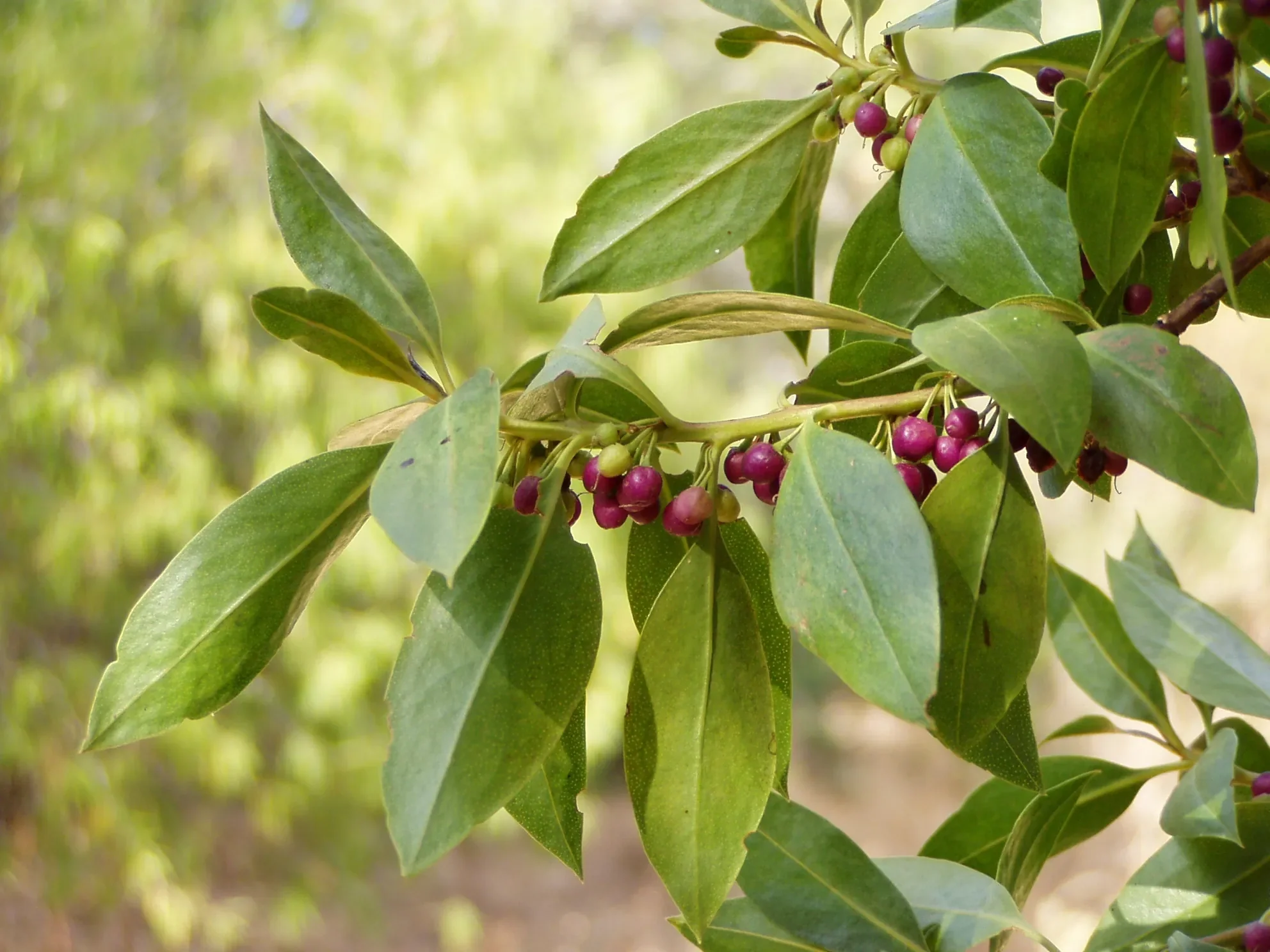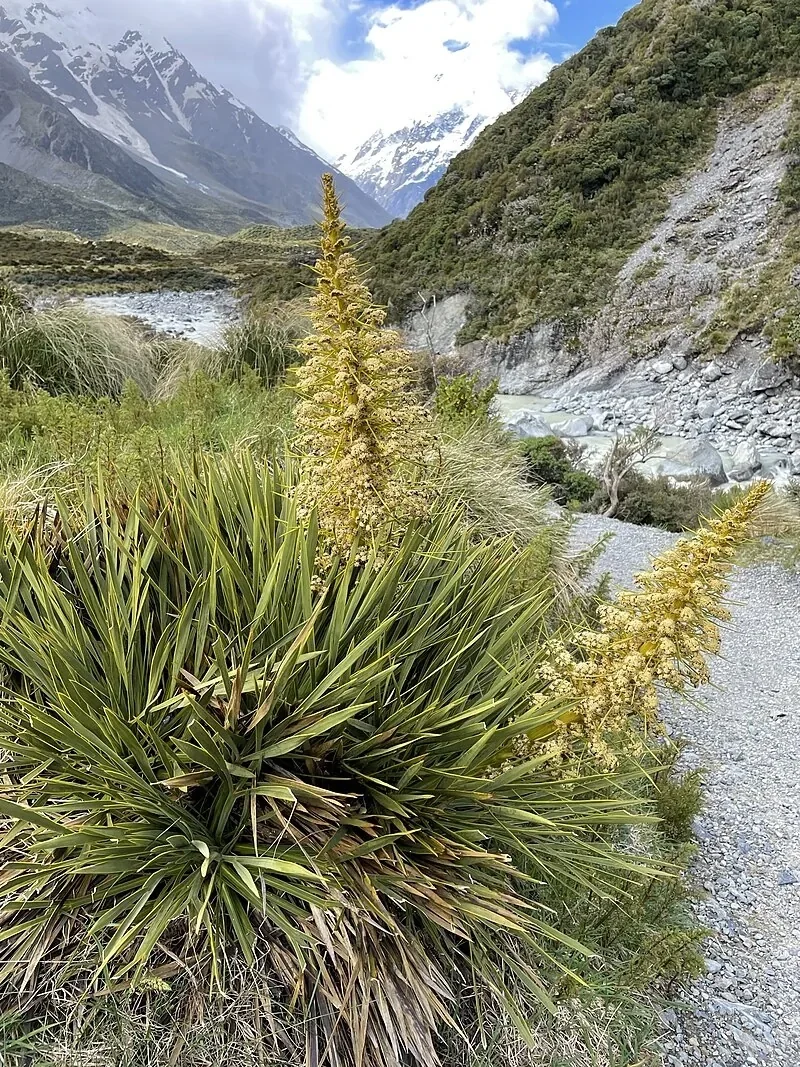
Ngaio
Myoporum laetum
Introduction
Introduction Overview
Myoporum laetum , also known as ngaio, is a coastal tree native to New Zealand. It is recognized for its glossy leaves, white flowers, and purple-spotted fruit. native trees .

Plant Description
Botanical Features
Ngaio ( Myoporum laetum ) is a fast-growing evergreen shrub or small tree native to New Zealand, reaching heights of up to 10 meters. Its leaves are somewhat fleshy, glossy yellow-green to dark green, lance-shaped, and conspicuously spotted with white to yellow glands. They typically measure 52-125 millimeters long and 15-30 millimeters wide, with small serrations along the edges. New growth is often very glossy, dark, and sticky. On older specimens, the bark is light grey to brown, thick, corky, firm, persistent, rough, and furrowed. White flowers with small purple spots are borne in clusters of 2 to 6 in axillary cymes, blooming from mid-spring to mid-summer. Following flowering, the plant produces a narrow-ovoid drupe that is 6-9 millimeters long and can be white, pale, or dark reddish-purple.
Quick Facts
Quick Facts Overview
| Scientific Name | Myoporum Laetum |
|---|---|
| Height | Up to 10 m (33 ft) |
| Spread | 4-6 m |
| Water Needs | Moderate (drought-tolerant once established) |
| Light | Full sun to partial shade |
| Frost Tolerance | Low to moderate (young plants sensitive to frost) |
| Salt Tolerance | High (excellent for coastal sites) |
| Growth Rate | Fast |
| Lifespan | Long-lived |
Climate Best Suited to
Myoporum is native to New Zealand and thrives in the country's diverse climate conditions. It adapts well to various regional climates throughout the country.
Regional Suitability
| City | Climate Suitability |
|---|---|
| Whangārei | Ideal |
| Auckland | Ideal |
| Hamilton | Ideal |
| Tauranga | Ideal |
| Rotorua | Ideal |
| Gisborne | Ideal |
| New Plymouth | Ideal |
| Napier | Ideal |
| Whanganui | Ideal |
| Palmerston North | Ideal |
| Wellington | Ideal |
| Nelson | Ideal |
| Christchurch | Ideal |
| Dunedin | Ideal |
| Invercargill | Ideal |
Natural Habitat
Natural Habitat Overview
Myoporum is naturally found in specific habitats throughout New Zealand. Understanding its natural environment helps in providing appropriate growing conditions in cultivation.
Plant Conservation
Myoporum laetum , commonly known as ngaio, has a conservation status that varies depending on the region. In its native New Zealand, it is generally classified as "Not Threatened" at a national level.
However, there are regional distinctions within New Zealand. For instance, in areas like urban Auckland, it is considered "At Risk - Regionally Declining" due to hybridization with Tasmanian boobialla (Myoporum insulare).
Globally, its conservation status is "Not evaluated (NE)" by some organizations, and NatureServe lists its global status as "GNR" (Global Not Ranked). In regions where it has been introduced, such as California, Myoporum laetum is considered an invasive species.
Soil
- Well-draining soil
- Tolerates most soil types
- pH 5.5-7.5
Light
- Full sun to partial shade
- Best growth in full sun
- Tolerates coastal exposure
Water
- Moderate water needs
- Drought tolerant once established
- Good drainage essential
Planting Guide
When to Plant
Plant ngaio in spring or autumn when soil is warm and moist.
Planting Steps
- Choose a site with well-draining soil and full sun to partial shade
- Space plants 1-2 m apart for hedging, 3-4 m for specimen trees
- Dig a hole twice as wide and the same depth as the root ball
- Add compost to poor soils if needed
- Position the plant at the same level as it was in the container
- Backfill and firm gently around the roots
- Water thoroughly and apply mulch
Note: All parts of ngaio are poisonous if ingested - take care when planting where children and pets play.
Myoporum laetum provides shelter and food for native birds and insects. Its dense foliage offers nesting sites, and the berries are eaten by birds. Ngaio helps stabilize coastal soils and supports biodiversity in restoration projects.
Uses and Significance
Garden Uses
- Ngaio is an excellent choice for hedging and screening, forming dense, attractive barriers that thrive in coastal conditions.
- It is ideal for coastal gardens, tolerating salt spray and exposed sites, making it a robust and resilient option.
- This tree is widely used for shelter belts, providing effective wind protection for more delicate plants and properties.
- Its berries attract native birds, making it a valuable addition to bird-attracting gardens and wildlife habitats.
- Ngaio can also be grown in large containers, allowing its glossy foliage and robust form to be appreciated on patios or decks.
Traditional Uses
- Traditionally, Ngaio was used by Māori for various medicinal applications (rongoā), including remedies for skin conditions and pain relief.
- The leaves contain a natural insect repellent (ngaione), historically used by Māori and early farmers to deter mosquitoes and sandflies.
- As a hardy coastal tree, it was also used for shelter plantings in traditional Māori settlements, protecting against harsh winds and salt.
Ngaio is ideal for coastal gardens, shelterbelts, and as a specimen tree. Its glossy leaves and spreading form add year-round interest. Use as a windbreak or to create privacy in exposed sites.
Seasonal Care Calendar
Spring
- Apply slow -release fertilizer if needed
- Mulch around base to retain moisture
- Ideal planting time for new ngaio
- Begin regular watering of young plants
Summer
- Water deeply during dry periods
- Watch for insect pests like scale
- Trim lightly to maintain shape
- Provide shade for newly planted specimens
Autumn
- Another good time for planting
- Reduce watering as temperatures drop
- Apply mulch before winter
- Clean up fallen leaves if desired
Winter
- Minimal water needed
- Protect young plants from hard frosts
- Major pruning can be done during dormancy
- Check for wind damage after storms
Pruning and Maintenance
Pruning and Maintenance Overview
Myoporum generally requires minimal pruning. Remove dead or damaged growth as needed and shape the plant to maintain desired form. Pruning is best done in late winter or early spring before new growth begins.
How to Grow Ngaio
Ngaio is a fast-growing, evergreen tree native to New Zealand, celebrated for its glossy, bright green leaves, white flowers, and distinctive purple-spotted fruit. This resilient coastal tree is highly valued for its ability to thrive in exposed, salt-laden environments, making it an excellent choice for coastal gardens, shelterbelts, and hedging. Its dense foliage provides habitat and food for native birds, contributing to local biodiversity. Understanding its propagation methods is key to successfully growing this versatile and ecologically important species.
From Seed
Propagating Ngaio from fresh seed is a straightforward and effective method. Collect ripe purple berries in autumn. Extract the seeds from the fleshy pulp and clean them thoroughly. Sow the seeds in a well-draining seed-raising mix, lightly covering them. Maintain consistent moisture in the seed tray, but avoid waterlogging. Germination usually occurs within 4-6 weeks under warm conditions. Once seedlings have developed a few true leaves, they can be potted into individual containers and grown in a sheltered environment before planting out. Note that all parts of Ngaio are poisonous if ingested, so handle with care.
From Cuttings
Semi-hardwood cuttings are a reliable method for propagating Ngaio, ensuring that new plants retain the exact characteristics of the parent. Take 10-15 cm cuttings with a heel of older wood from healthy, semi-hardwood stems in summer. Remove the lower leaves and dip the cut end in a rooting hormone. Insert the cuttings into a well-draining propagation mix with good aeration. Keep the cuttings in a warm, humid environment, out of direct sunlight, perhaps under a plastic dome or in a propagator. Roots typically develop within 6-8 weeks. Once rooted, the new plants can be potted on and grown in a sheltered environment until they are ready for planting.
Pests and Diseases
Common Pests
- Scale insects - treat with horticultural oil
- Thrips - can cause leaf distortion, treat with insecticidal soap
- Mealybugs - occasionally affect new growth
Diseases
- Root rot in poorly drained soils
- Leaf spot fungal diseases in very humid conditions
- Generally disease resistant when grown in appropriate conditions
Cultural Significance
Myoporum laetum , commonly known as ngaio, holds significant cultural importance, particularly within Māori culture in New Zealand.
Key Aspects of Its Cultural Significance Include:
- Traditional Māori Uses: Māori extensively utilized the ngaio tree. Its bark was used for medicinal purposes, and the wood was fashioned into fishing gear, tool handles, and weapons. The tree was also employed for erosion control and as a shelterbelt.
- Medicinal Properties: Ngaio had various medicinal applications. Māori chewed leaf buds to soothe stomachs after consuming bad mussels. The inner bark was scraped and rubbed on sore gums and teeth to ease pain, and an infusion with water was used to treat cuts, bruises, ulcers, and skin conditions.
- Insect Repellent: The leaves of the ngaio tree contain a toxin called Ngaione. Māori discovered that rubbing the leaves on their skin acted as an effective insect repellent against mosquitoes and sandflies. Early farmers also used it as a sheepdip to ward off parasites.
- Māori Mythology: The ngaio tree is featured in Māori legend, specifically in the "Man on the Moon" myth. In this story, a woman named Rona, angered by the moon obscuring her path to collect water, was pulled up to the sky by the moon. She clutched a ngaio tree, which was torn from its roots and carried with her into the night sky, where the craters on the moon are said to resemble Rona holding the tree.
- Ecological Role: Beyond its direct uses, ngaio plays an important ecological role, providing habitat for native birds and insects and serving as a food source for the native New Zealand pigeon (kererū). It also helps stabilize coastal sand dunes and prevent erosion.
Bonus Tip
Expert Growing Advice
The leaves of Ngaio contain a toxin called ngaione, which can be harmful to some animals. However, Māori traditionally used the leaves as an insect repellent by rubbing them on their skin. Early farmers also used it as a sheep dip to ward off parasites.







